Alchemists Cu29: A Great Watch Overshadowed By Woo?
Quality products are what every consumer hopes for, but making a great product doesn’t necessarily translate into sales. So ad agencies regularly cook up ideas to catch the public’s attention, often leading to strange or gimmicky tactics to highlight features or entice people to try something new.
Sometimes it can work, like food mascots that have people associating a handsome pilot with their favorite frozen pizza (or watch brand).
But as often as a marketing gimmick succeeds, three more will fail spectacularly, sometimes leading to apologies from a brand, a recall of a product, or even the failure of an entire company.
And that makes you wonder: if your product is really as good as you think, do gimmicks undercut the product and cheapen it? Are gimmicks the acceptable reality of modern advertising or the refuge of those who don’t truly believe in their products?
There is surely need to stand out, and if you are making a generic product to be sold to the broadest of demographics you may just have to be a bit shocking or weird to get anyone to pay attention. But if you are making a product that sells only to the richest of the rich and has taken years of hard work and ingenuity to craft, why would you place your hopes on what could well be considered a gimmick?
I get that Skittles can run with “Taste the rainbow” and depict a giraffe eating a rainbow, being milked for its solid sugar candy that in all honesty might to lead to diabetes. It’s kind of a hard sell in a health-conscious world.
But does Ferrari run ads highlighting a pony being fed handfuls of Red Hots before transforming into a supercar? The answer is no, seriously no. The car company believes in its products and advertises them based on their merits (even though it has plenty of direct competitors selling similar, and sometimes less expensive, comparable cars).
So why would a watchmaker selling an extremely limited high-end watch for just shy of CHF 200,000 lead with a concept centered on a dubious health claim that is easily debunked and yet forms the basis of the brand “DNA”?
I honestly don’t know, especially because the piece is a fantastic example of watchmaking mastery and enjoys the quiet support of one of the biggest names in independent watchmaking.
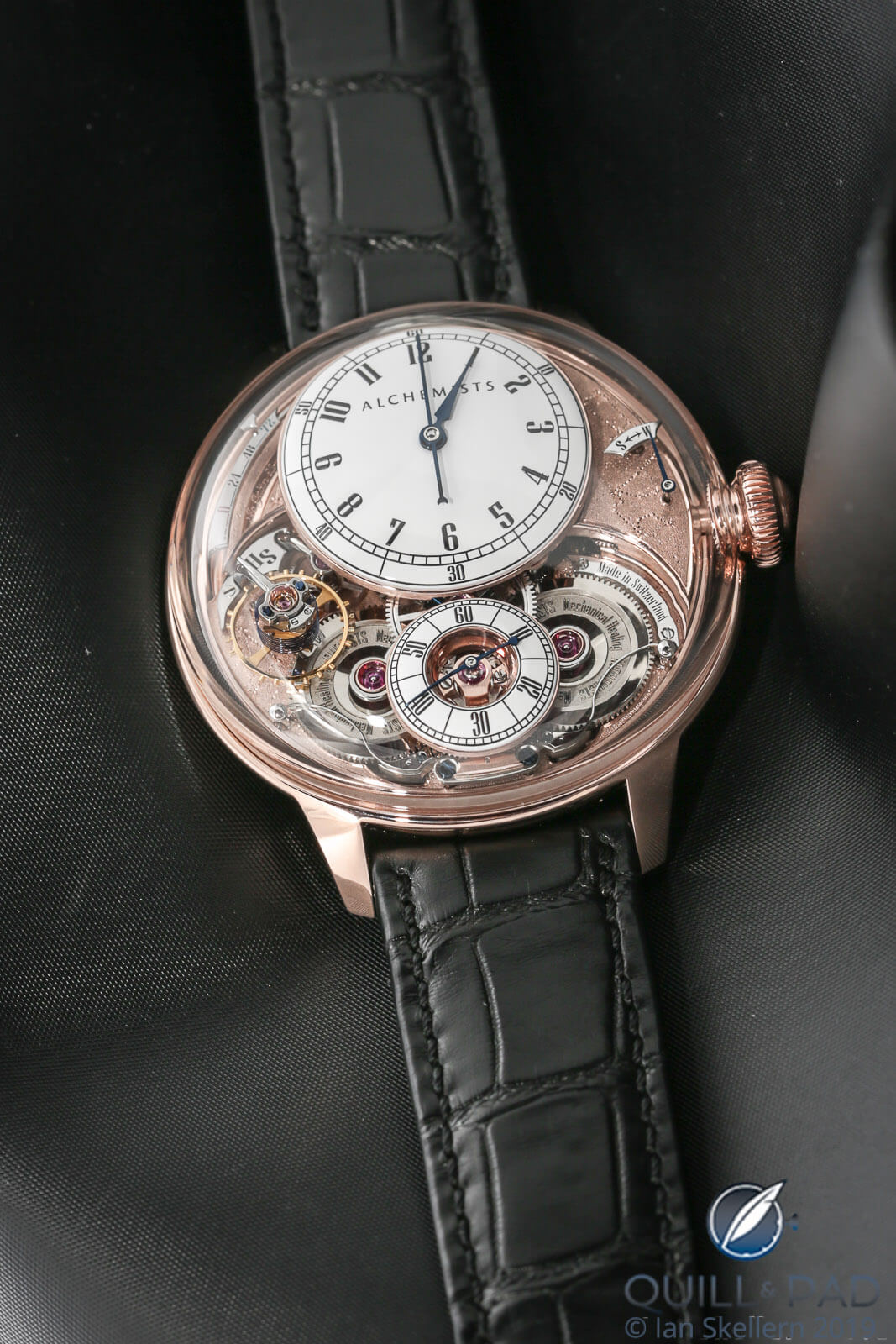
Alchemists Cu29
I am of course talking about Alchemists Cu29 launched at Baselworld 2019 with a watch boasting some incredible details and a unique case material, but also pushing some questionable claims. So let’s dig into the new creation and discover the truth of the matter.
Alchemists Cu29
Firstly, I want to emphasize how much I love the look of this piece and am enamored by some of the design choices put into the movement, case, and crystal. The Cu29 bears all the hallmarks of true haute horlogerie all the way from the three-dimensional exposed movement and cylindrical hairspring to the exquisite finishing and ridiculously cool ultra-domed crystal.
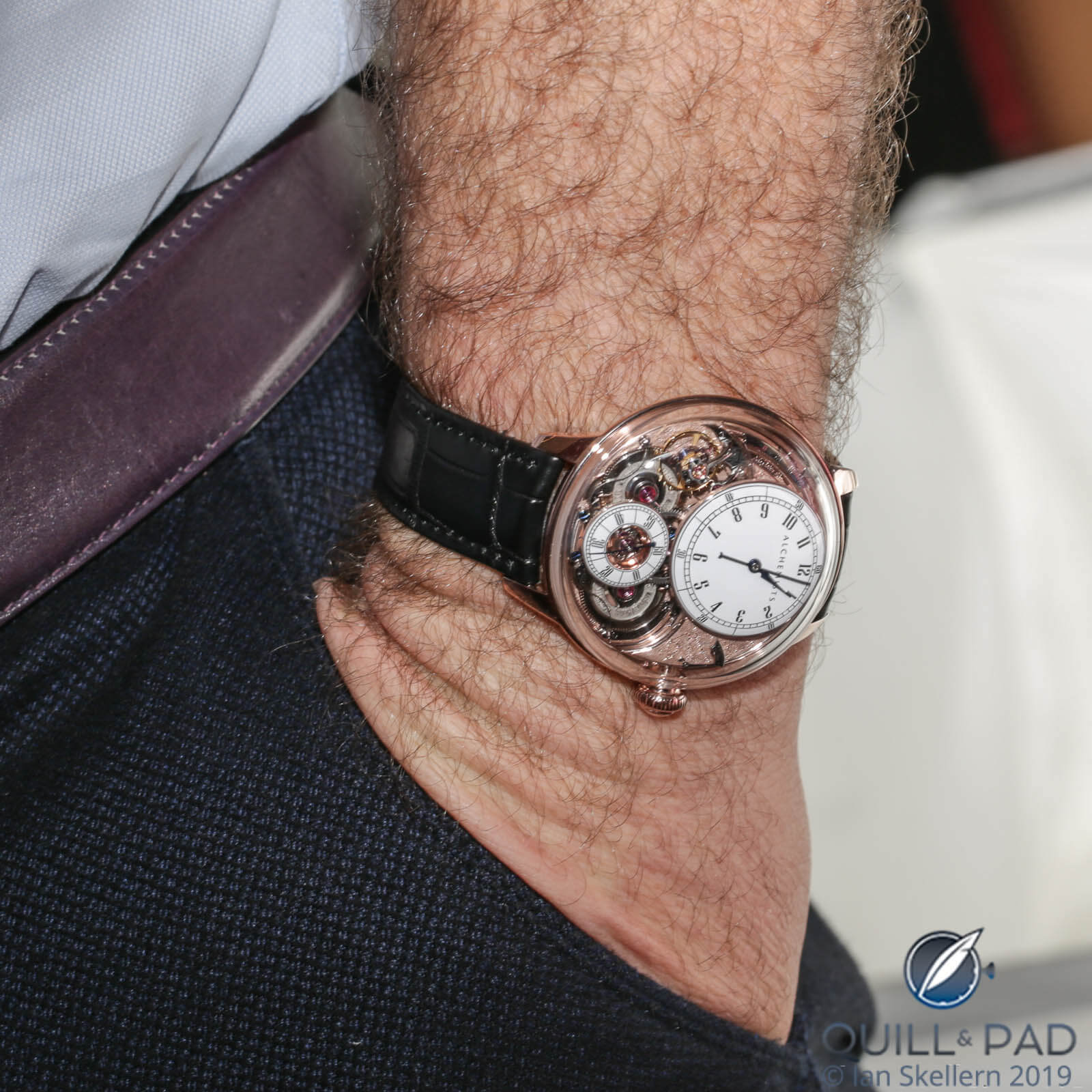
Alchemists Cu29 on the wrist
Every single component on the Cu29 has been considered extensively, and the movement design was done as much for functionality as it was for beauty.
The proportions of the layout are superb with the upper domed hour-and-minute dial in semi-precious stone balancing out the domed subdial (also in semi-precious stone) for seconds flanked by a spring barrel on either side.
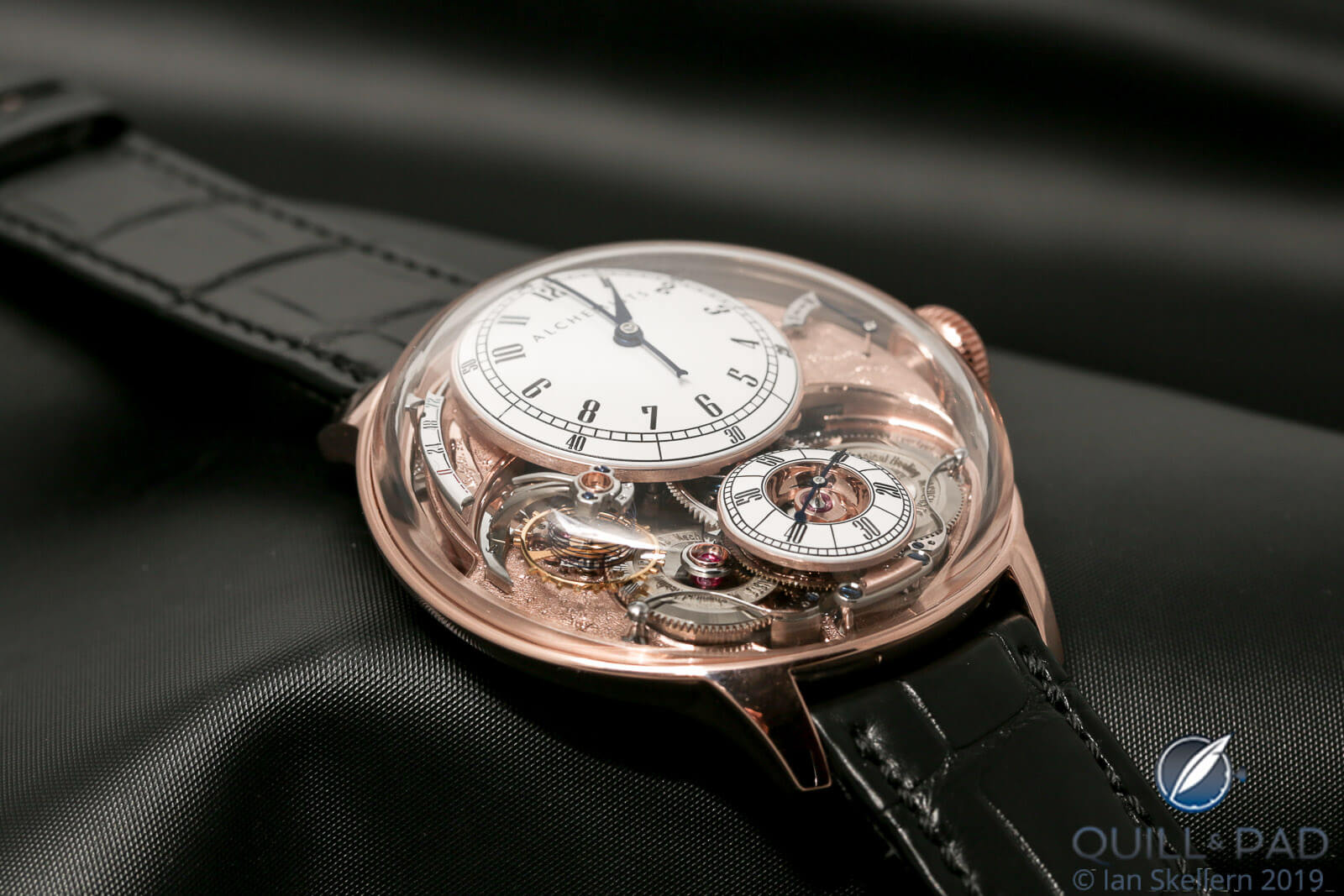
Alchemists Cu29
This layout is supported on the left side by the suspended balance wheel oscillating on a cylindrical hairspring and the power reserve indicator that offsets the contrasting simplicity of the right side with it function selector.
All of this is captured under an ultra-high domed sapphire crystal that eliminates the need for a bezel and wraps all the way down to the crown stem.
And there’s even more: the crystal is machined with a small arc straddling the winding stem to keep the crystal low enough to provide ample viewing of the multilevel movement. All of the interesting bits are on the front so the makers have kept the rear of the watch covered with a solid case back.
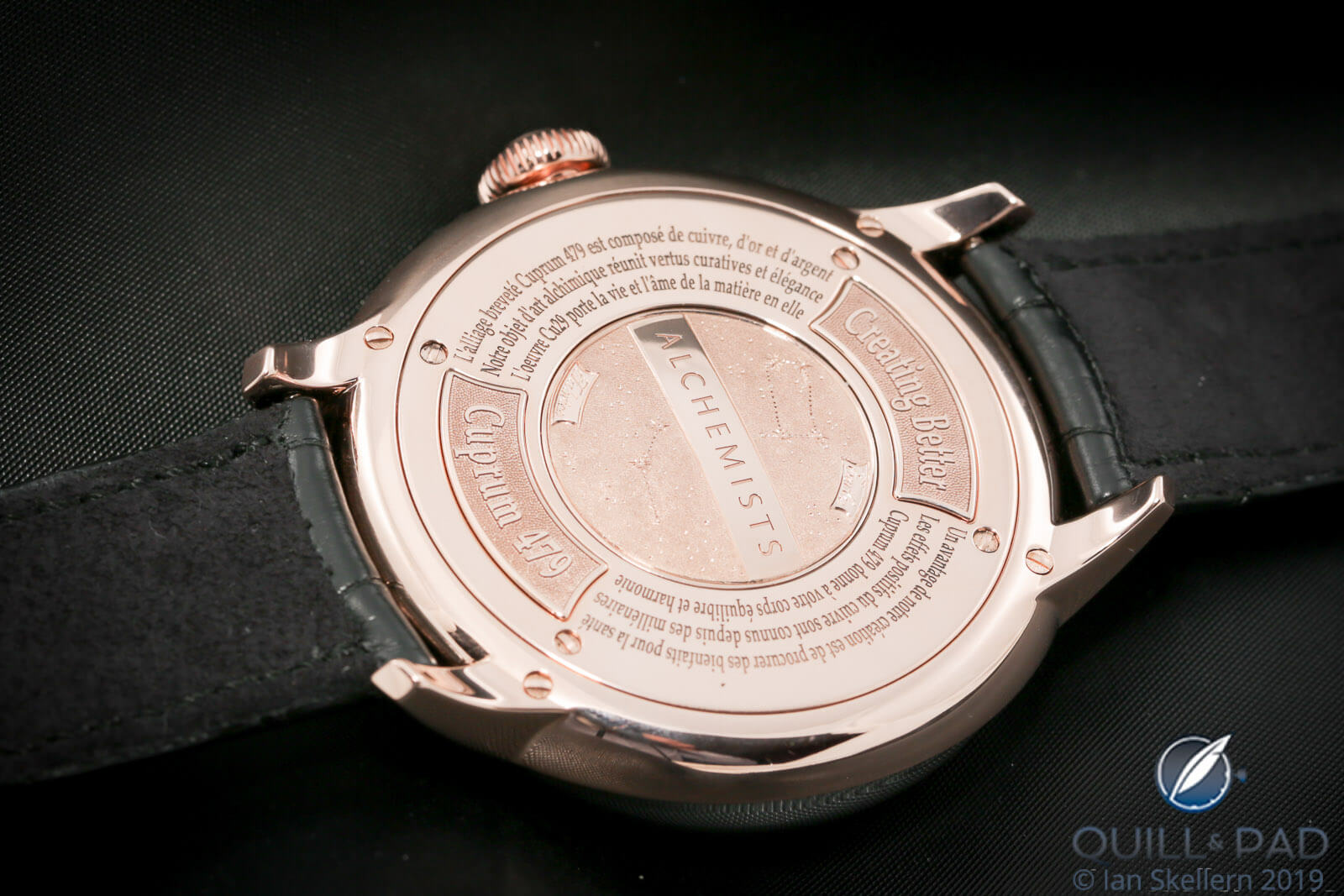
Engraved case back of the Alchemists Cu29
This is where the brand ideology is engraved across the cover, which presents the supposed benefits of the patented case material “Cuprum 479,” which I will come back to in a bit.
Since the crystal replaces the bezel and goes so far down to expose the movement, the watch appears thinner than it is since the solid portion of the case has a smaller profile. This is a useful design tactic to make a relatively thick watch (15.4 mm) seem more reasonable to those concerned about large sizes.
At 44 mm in diameter the watch is clearly a big boy, but that dramatic domed crystal plays well with the dimensions to keep the visual impact reduced for size yet provide a stunning glimpse at the movement construction.
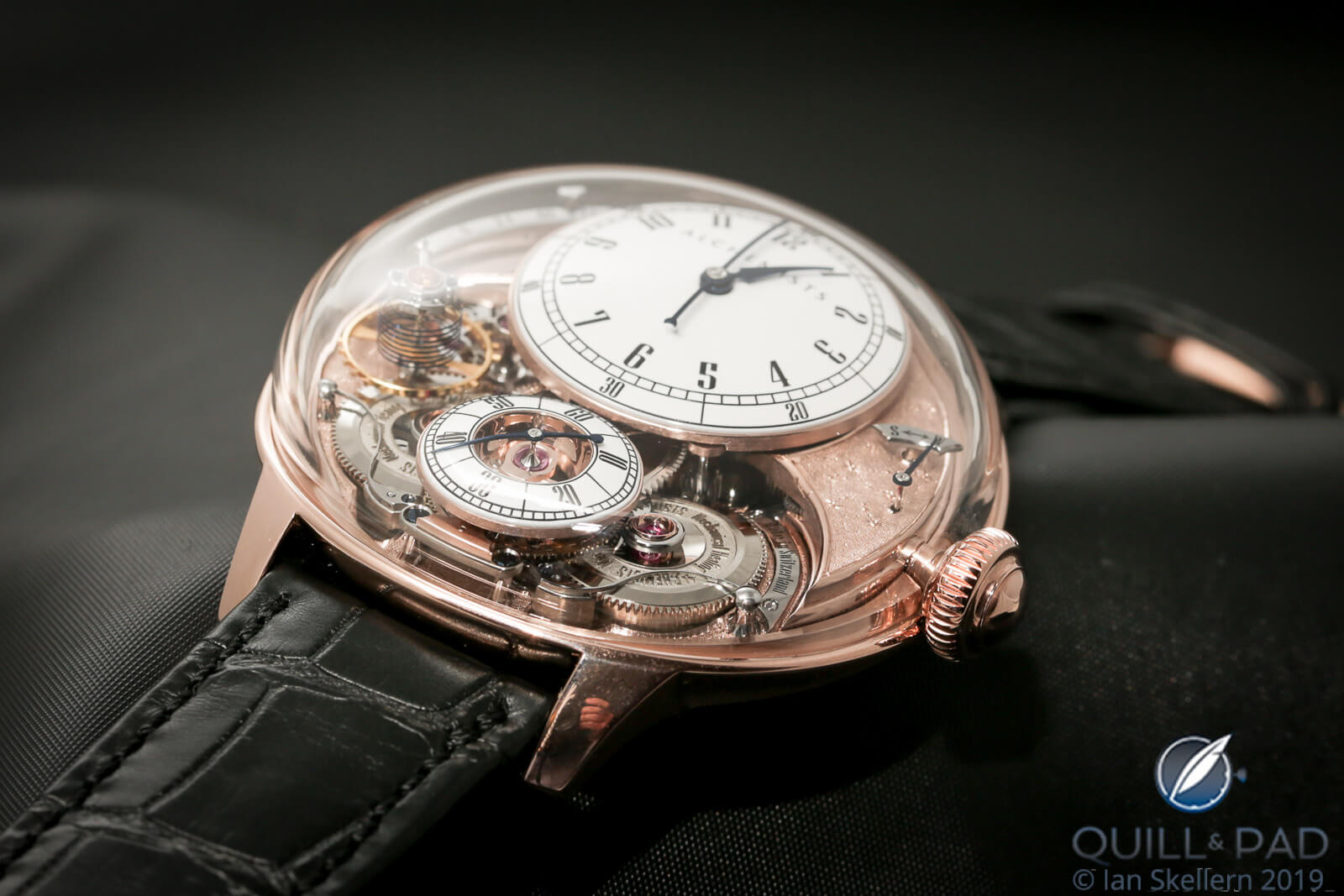
Alchemists Cu29
Overall, the details of this watch sing, making it clear that this is serious watchmaking. The power reserve is a small arrow indicator coming up from the edge of the movement over the top, something made more interesting by the view of the crystal’s low waistline. The same sidelong view allows even more appreciation of the suspended balance with cylindrical hairspring since the entire height of the assembly is visible.
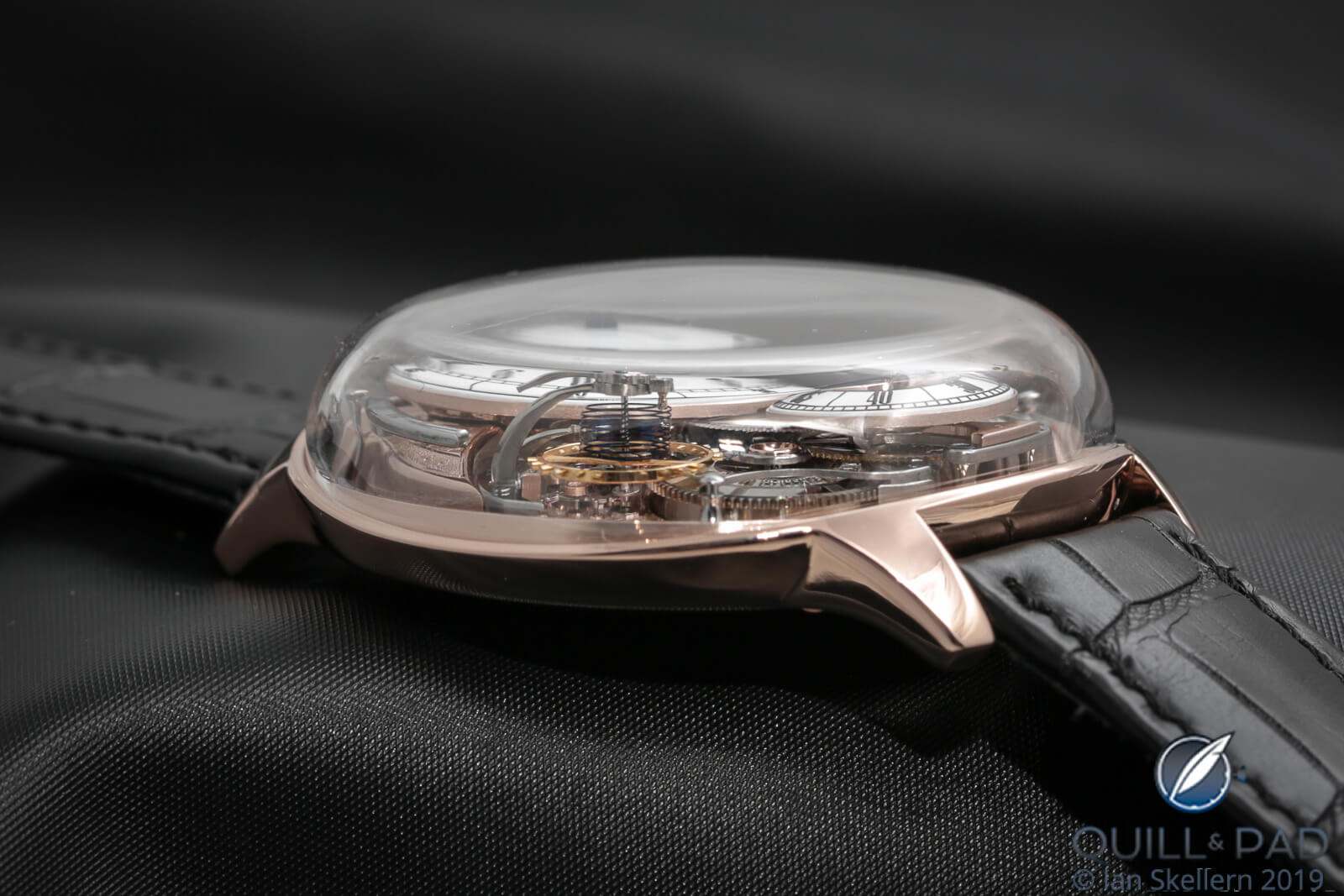
A view of the cylindrical balance spring of the Alchemists Cu29
It also lets the wearer see deeper into the bowels of the excellently finished movement, aiding the details in standing out all over the place. One of my favorites is the curved click springs on either side of the movement that gracefully arc over the barrels, restrained only by polished pillars.
The entire thing feels a bit like a terrarium, with a miniature world living inside the domed cover.
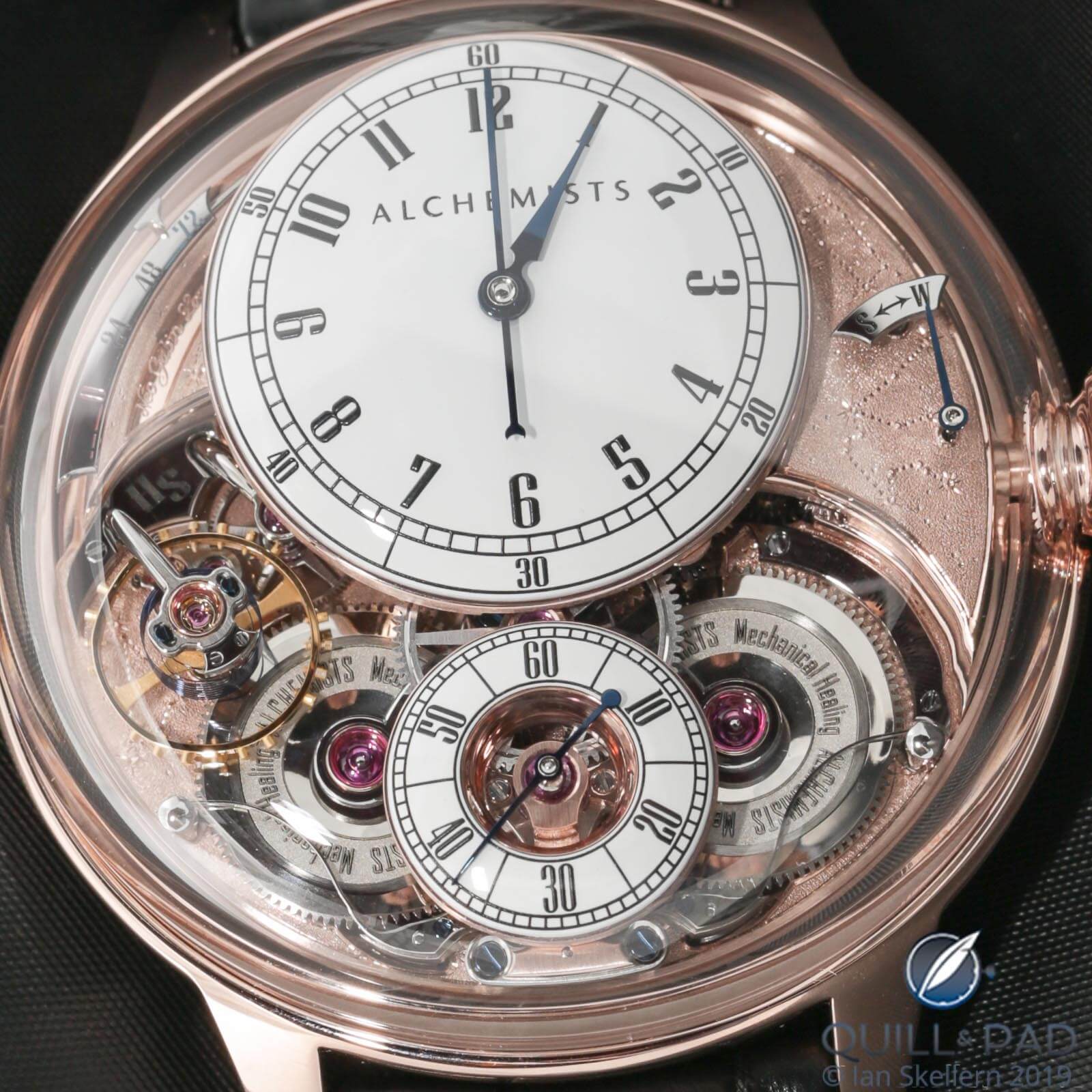
Alchemists Cu29 up close
There is a sense of wonder, and I think that might possibly lead us back to the reasons why the maker put so much stock in the “wonders” of copper.
Alchemists Cu29: Cuprum 479
First off, when an entity patents something and then tries to act like it’s a secret in their marketing, I find it silly. A patent means the entity has publicly declared the invention.
As a result, I was able to obtain access to the patent, which can be found under the patent number CH714879A2 (Swiss designation) or alternately WO2019197941A2 (European designation).
No secrets here, guys, because secrets only seek to confuse and hide the truth.
WARNING: NUMBERS & FIGURES ALERT!
Upon closer inspection of the patent, we see that the specific patented “alloy” is actually a range of possible alloy combinations that fall within stated limits.
The patent calls for an alloy that comprises copper in a total amount between 50-90 percent by weight (typically 75-85 percent), silver in a total amount between 0.1-20 percent by weight (typically 5-15 percent), gold in a total amount between 0.1-40 percent by weight (typically 5-15 percent), and the optional addition of one or more components chosen from palladium, zinc, platinum, iridium, nickel, iron, and silicon in a total amount up to 20 percent by weight (typically 5-15 percent).
Now anyone with a basic understanding of metallurgy can see that this is a very broad patent covering dozens, if not thousands, of possible combinations of metals, literally including the possible alloy ingredients of historical precious metal alloys that are of unknown recipes such as Corinthian bronze.
Based on the numbers presented in the patent, it falls just outside of what could technically be considered 9-karat gold as well, which was a comparison used in the patent application to present a relatable prior technology case for that specific alloy.
The patent goes on to describe different general embodiments of the alloy and specifically calls out palladium as the only optional ingredient outside of the main three (copper, silver, and gold) in an amount between 0.1-5 percent by weight.
However, it then follows this up by discussing a specific recipe using 85 percent copper, 7.5 percent silver, and 7.5 percent gold with no additional metals and uses this version to discuss its application in a watch case, crown, and hands, but again specifies the example is not to limit the patent to this specific recipe and intended use.
So that is as close as we are going to get to understanding exactly what this Cuprum 479 is as it could very well comprise dramatically different alloy recipes and still fall under the patent.
That is because patents are a funny thing: they can cover a lot of stuff and have a variety of claims, none of which have to even be true. They simply must not overlap or infringe on another currently valid patent.
The patent does cite a 2012 patent for a low gold-content alloy, largely to show that this patent is different. But that is not where the bulk of the patent focuses.
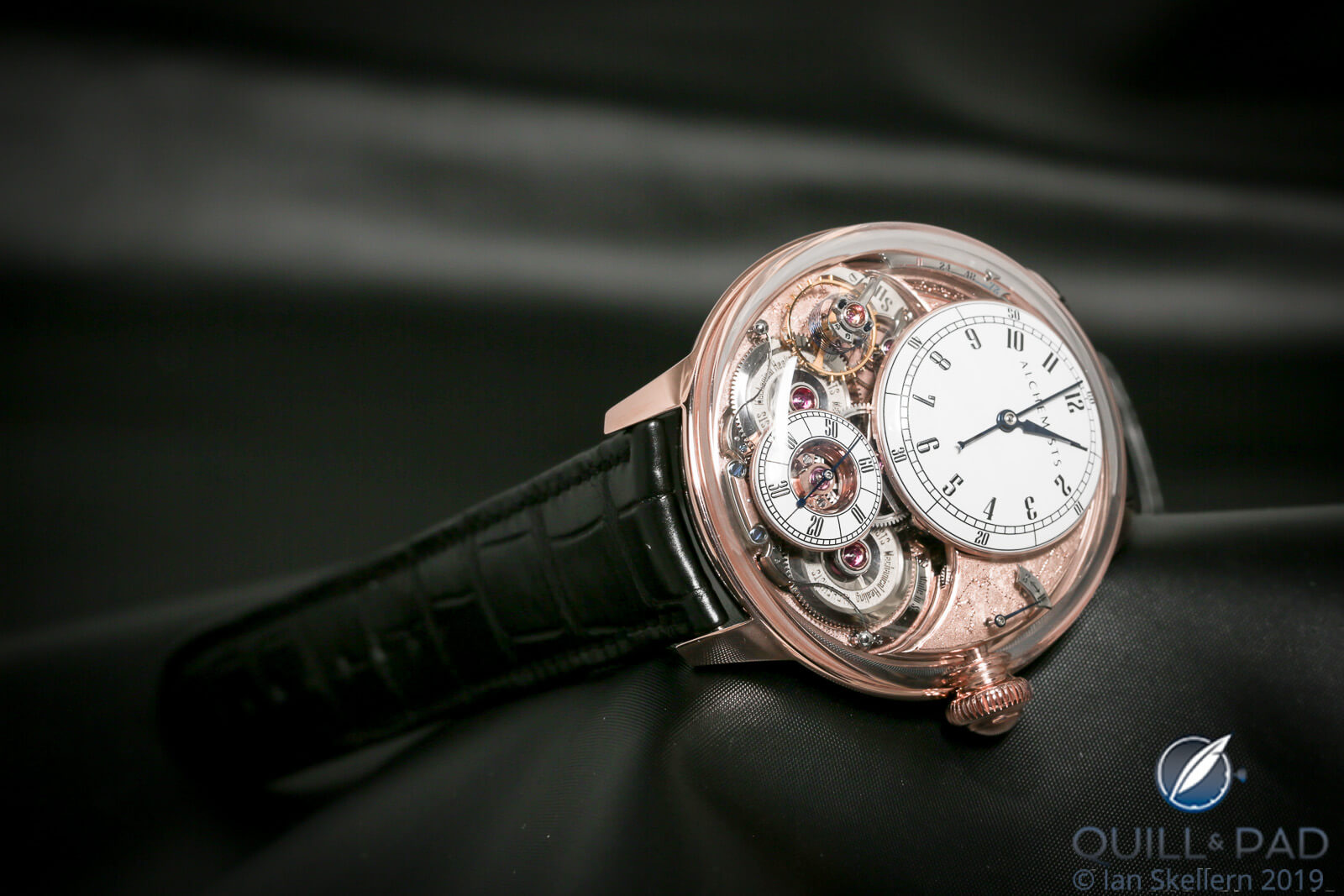
Alchemists Cu29
The “healing property” copper
Mostly it just outlines all the possible recipes and amounts that can fall under this patent and for what intended use, using four-fifths of the description text and all nine included claims to build the patent case.
But why did I bring up the “claims” as being different from the description?
Well, claims are the specific things presented for what the patent legally covers, meaning what the patent will prohibit people from doing without compensating the patent holder. Claims are to-the-point and unambiguous, though do not have to be definitively proven or real. Just explicit.
The description, however, can include arguments, examples, and discussions of prior inventions to create a case for acceptance and publication of the patent. To build a strong case for a patent application, the claims should be clear and simple, and any flowery language or unsupported claims should be delegated to the description which is there to support the “claims.”
And now we come full circle to Alchemists tagline: “Mechanical Healing.”
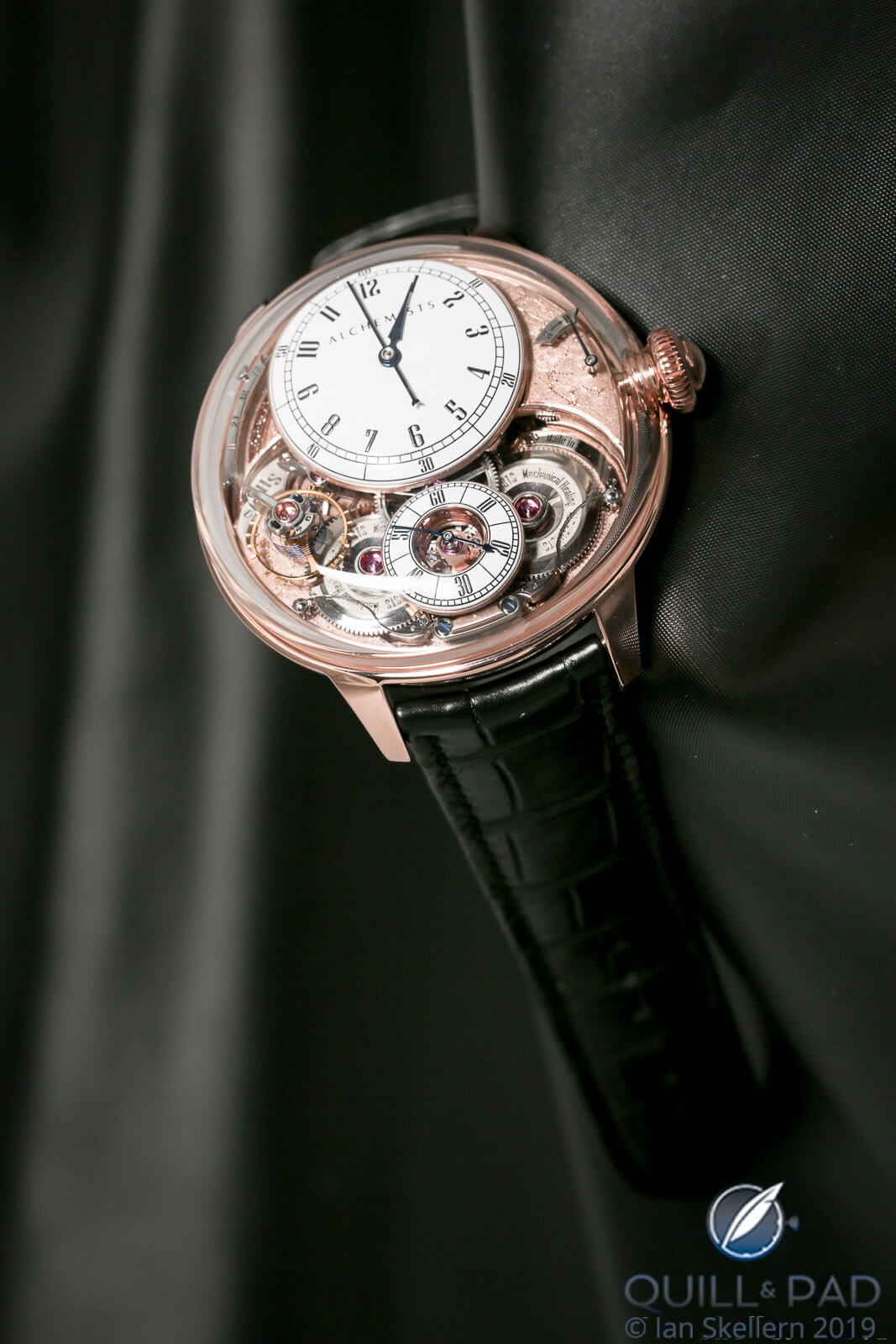
Alchemists Cu29
The boutique brand has made the supposed healing qualities of copper into a main selling point, and it all comes down to specific claims about what the copper alloy can do for the human body. These claims are not listed under the official “claims” of the patent but are present in the description text.
The claims are that the alloy provides health benefits when worn by the user; it has therapeutic benefits proven by ancient civilizations; wearing copper bracelets treats joint pain from osteoarthritis; wearing copper can help those people suffering from copper deficiencies; wearing the alloy against the skin allows absorption through the epidermis to the blood to regulate copper levels within the body; the benefits have been proven by many scientific studies including one from 1983 in Australia that showed patients noticing reduction in arthritis pain when wearing copper bracelets.
Do the claimed benefits of copper pass muster?
Let’s work backwards through these.
The patent cites a study from 1983 in which Australian doctors G.R. Struthers and D.L Scott from St. George Hospital found that arthritis sufferers noticed significant reduction in joint pain while wearing copper bracelets. The doctors could not figure out why but concluded it must be some mechanism or reaction with the copper (a well-known and long-held folk remedy).
This should already ring alarm bells. The study was designed to test out alternative pain relief methods and did not seek to test any mechanism for how copper might alleviate pain, meaning that the conclusions could only ever be determined to be coincidental or correlated, but not caused by the copper. It just wasn’t part of the test.
More recent studies have found the likely cause to be the placebo effect (a very real phenomenon not to be discounted), and with subjective quantifications of pain no hard data could be used to describe or predict a physical mechanism for pain relief from contact with copper.
Other tests have been conducted to examine how copper is absorbed into the body through the skin, which could then be used by the body for internal processes of pain relief or to help balance the needs of the body for copper as a nutrient.
No clear evidence has been found that copper can even be absorbed through the skin from such a source, nor would it usually be needed for the average adult. In fact, too much copper in the body is a toxin and can lead to vomiting or liver damage, something seen in people regularly using copper cookware.
From there the rest of the claims are based on variations of these ideas or the vague conclusions drawn from unsupported statements.
So the claims about health benefits, while not definitively disproven (it is really hard to disprove something that makes no firm, testable predictions, often known as being unfalsifiable), seem as if they are based on a combination of historical popularity, outdated and unsubstantiated studies, and anecdotally misattributed effects possibly relating to the placebo effect.
And while the placebo effect is indeed real and sometimes very powerful, it doesn’t lead me to trust the claims put forth by the people at Alchemists.
And that brings us back to the beginning and my original quandary: why would such an incredible piece of watchmaking craft and engineering lean so firmly on such claims? Well, because that’s marketing.
The mainstream watch brands touting heritage, tradition, exclusivity, and craftsmanship are often overstating such ideas, if not outright playing make believe. Yet it is more or less accepted as a way to set one’s watch brand apart. Most people know its fluff, yet they engage with it.
The Alchemists’ use of a special copper/silver/gold alloy is interesting and getting a patent for a new family of copper alloys and its use in watchmaking is cool to be sure.
One of the founding members, and the man behind the alloy formulation, is a naturopathic herbalist with a background in natural remedies for common ailments. I understand the excitement of trying to bring attention to a new project by focusing on one’s own inspiration and experience; it makes sense that it would be a major piece of the brand ideology.
More reading: Copper Bracelets ‘Don’t Help Rheumatoid Arthritis’ and Copper bracelet
Tread lightly
But where the Alchemists tread that most brands don’t is to promote specific (yet unproven) health benefits as a feature of an ultra-luxury wristwatch.
Heritage and tradition are abstract concepts, health claims are not.
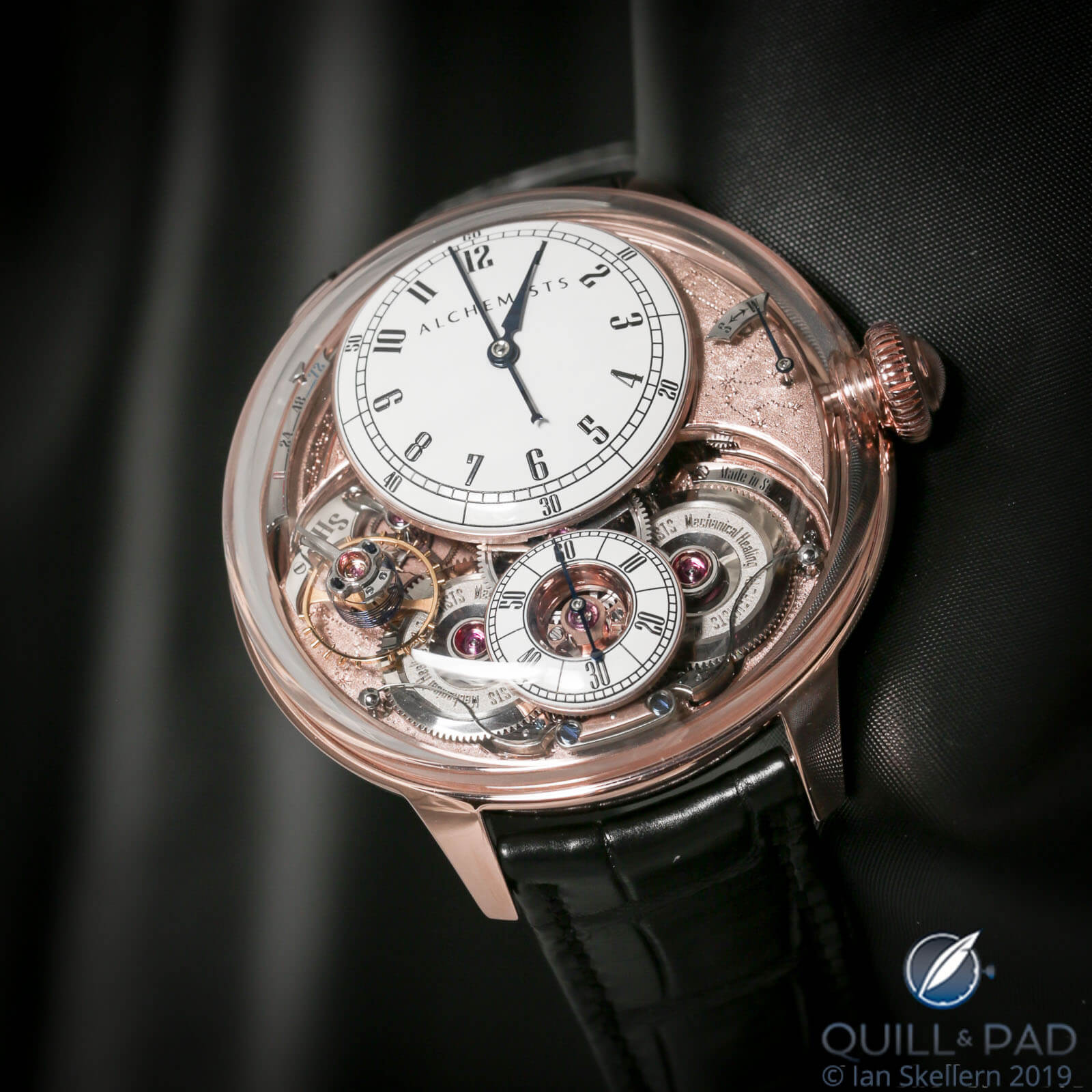
Alchemists Cu29
For comparison, the brand also makes a claim that the Cuprum 479 alloy is more stable than 18-karat gold, and while this seems like a questionable chemistry fact it is something that can be independently verified and does not seek to make a medical claim.
Even if it turned out to be inaccurate, I would be much more forgiving on that fact than unsubstantiated health claims.
So I leave it where I started: wondering if the purported health benefits are just a gimmick – a MacGuffin, if you will – meant to get people talking so they spend time looking at the watch.
I know the high-end watchmaking market is becoming surprisingly saturated with awesome products, even ones that have Philippe Dufour’s personal approval (which is akin to being knighted by Queen Elizabeth), but does that mean that companies have to come up with some gimmick to bake into the brand just so it stands out?
If so, will that gimmick just overshadow the product if it is too far out there or – like in this case – too pseudo scientific? I really don’t know, and it makes this watch such a fascinating case study.
If the brand had just patented the copper alloy as a durable replacement for red gold and left it at that, would this watch be a highlight of the year 2019? Would it have won at the Grand Prix d’Horlogerie de Genève?
I think it could have; it sure has the horological chops to be great.
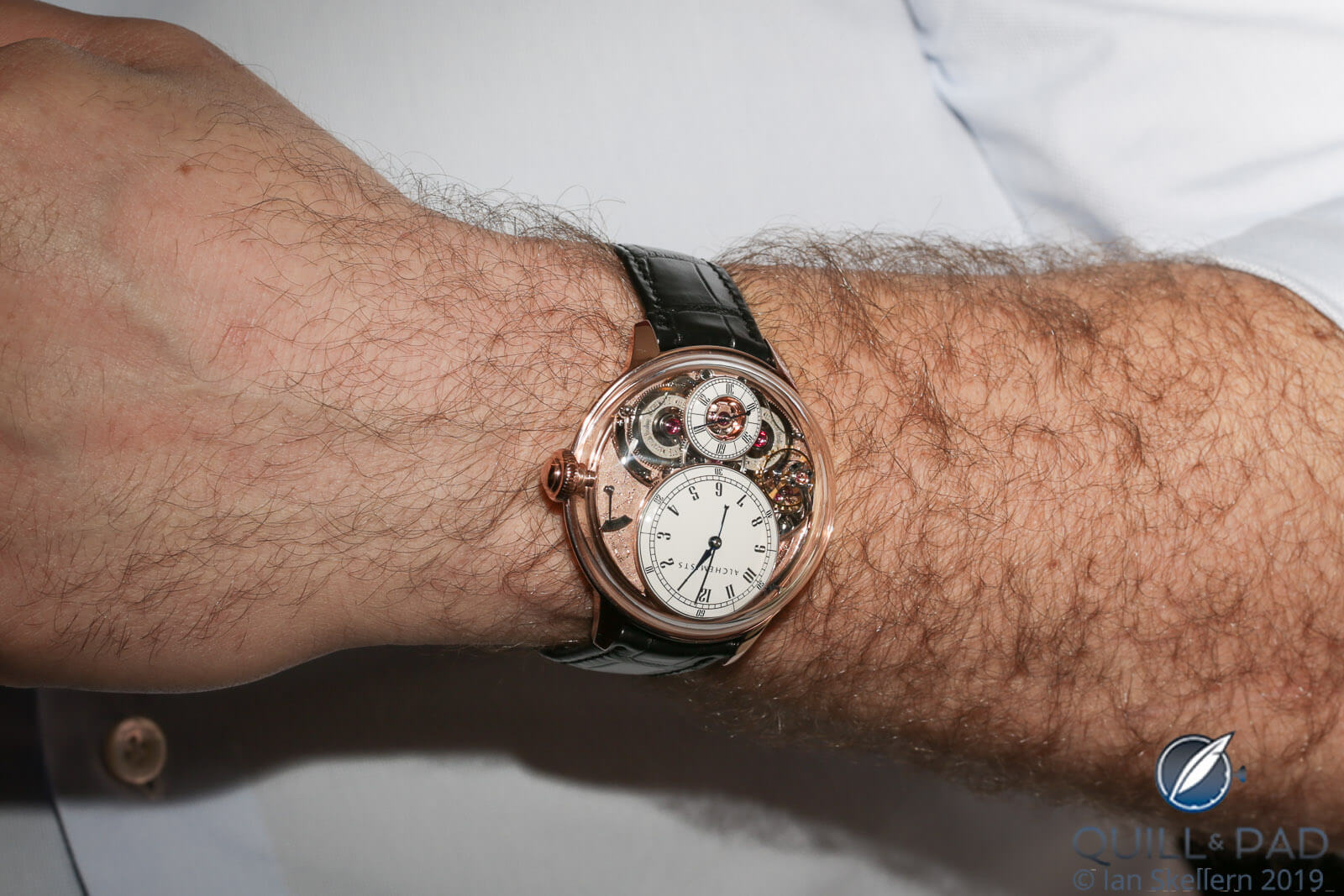
Alchemists Cu29 on the wrist
I just get the sense that people’s reactions to the Alchemists Cu29 would be like dating a really great person only to find out they are your cousin through marriage (not blood). It doesn’t make it any technical difference, but there is this nagging weirdness that just changes things.
I love nearly everything about the Alchemists Cu29, and I hope the boutique brand is able to settle into a groove and develop some really cool watches.
And I have hope the unsupported health claims make an exit before they are seen simply as a gimmick that undercuts the legitimacy of the incredible product. But, hey, what do I know? I’ve never sold a CHF198,000 watch!
I broke a lot of things in this one, so let’s continue by breaking this piece down!
- Wowza Factor * 9.8 Visually the Cu29 does not disappoint; it is everything you might want in an independent haute horology piece!
- Late Night Lust Appeal * 98» 961.052m/s2 The ability for this watch to keep you guessing, from its awesome mechanics to the baffling health claims, certainly has something to keep you awake at night!
- M.G.R. * 63.4 The movement is a top-notch assembly of stunning finishing and beautiful mechanics, and it even has the endorsement of Philippe Dufour!
- Added-Functionitis * Moderate It comes with a power reserve and function selector, enough to move it out of the realms of being time only. That’s good enough to need regular strength Gotta-HAVE-That cream!
- Ouch Outline * 12.1 The dirty feeling of wanting something that contradicts your entire philosophy but checks a lot of boxes! Compromising yourself is a hard thing for most people to do, and to fully support a product that makes dubious health claims just because it is awesome can be a tug of war with yourself. I don’t know if I can win that tug of war in either direction, so I’m stuck twisted in knots.
- Mermaid Moment * But, it’s cool if you ignore that other stuff! They say that love can be blind. But sometimes you are fully aware of the problems a union might cause and you hesitate to actually say I do. I’m still in that camp. But darn if it isn’t a truly cool watch on its own!
- Awesome Total * 844 Begin with the number of components in the movement (362) and add the number of the patented alloy (479), then tack on the number of founders of Alchemists (3) and the result is a weirdly interesting awesome total!
For more information, please visit www.alchemists.swiss.
Quick Facts Alchemists Cu29
Case: 44 x 15.4 mm, patented Cuprum 479, a copper, silver, and gold alloy
Movement: manually wound Caliber 003 with suspended balance on a cylindrical hairspring, 3 Hz/21,600 vph frequency
Functions: hours, minutes, seconds; power reserve, function selector
Price: CHF 198,000
Leave a Reply
Want to join the discussion?Feel free to contribute!



Excellent article of one of the coolest watches that I have seen this year.
Dufour has lost the plot.
Gorgeous watch. However, thjanks for this article about those dubious claims. I would like to add that the patent that you are pointing at is actually not delivered, and the European Patent Office issued a negative report due to lack of novelty and lack of unity of the invention. Which means that they will have to either withdraw it or modify it extensively.